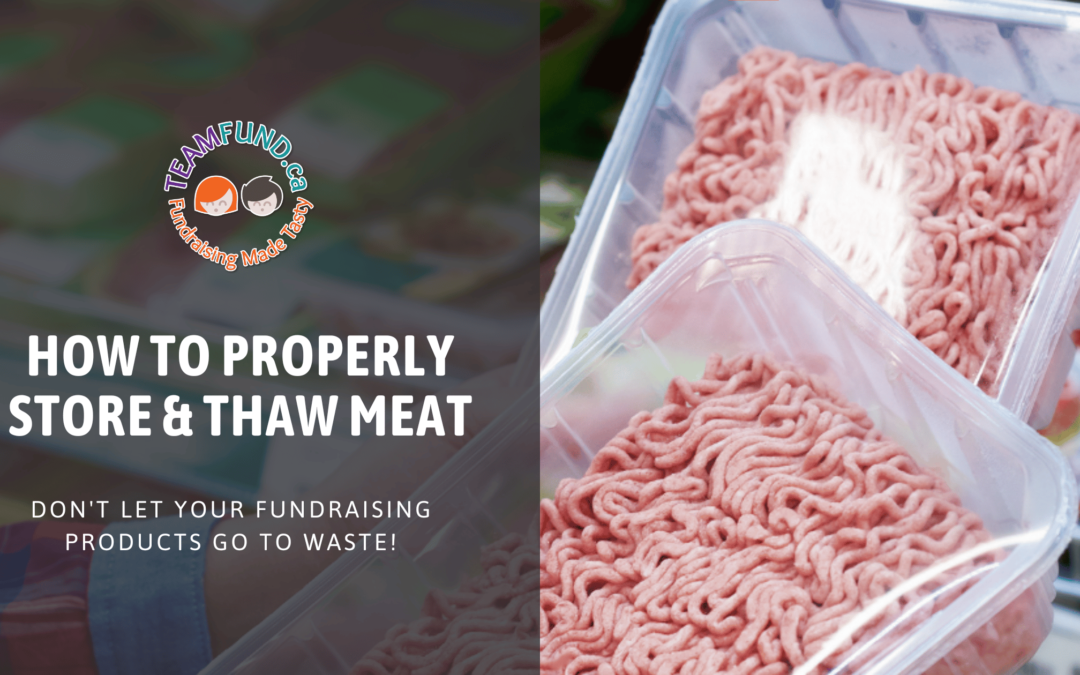It’s getting close to springtime, which means that spring and summer sports teams are gearing up for a new year of fun and excitement on the field!
With many minor sports teams fundraising with meats and other foods for barbeque season, we felt it was important to help educate parents with the important knowledge of how to properly store and thaw meat.
What Does Proper Meat Storage Mean?
You may be saying to yourself, “I’ve been putting meat in the freezer for years and never had a problem,” and fingers crossed, you never will. However, proper food storage can help extend the lifespan of your meat, help it keep its flavour, and help avoid anyone getting sick.
Freezing Your Meat 101
Fundraising with meat for your sports team is one of the most profitable and fastest ways to raise money.
However, it is important to remember that meat is meat, and it can go bad if left out. Freezing food you are not using is rules 1, 2 and 3 for proper food storage.
Freezing your meat stops the metabolic process of all the microorganisms that live on everything.
When they’re frozen, they can’t grow and multiply like they can at room temperature.
This is key because those micro-organisms are what turn your meat bad. By freezing them, you stop them from growing and multiplying and wrecking any delicious meat you’ve gotten from your last fundraiser.
You’ll want to keep your freezer at -18° C or lower to freeze your meats effectively.
It is important to remember that once you thaw out your meat, those micro-organisms become active again.
You need to thoroughly cook your meat to kill off those organisms before you try your food.
Different foods have different minimum temperatures you need to reach to kill off all dangerous organisms.
Below is a table of proper meat temperatures for safe consumption:
| Category | Food | Temperature (F) |
| Ground Meat & Meat Fixtures | Beef, Pork, Veal, Lamb | 160 |
| Turkey & Chicken | 165 | |
| Fresh Beef, Veal, & Lamb | Steaks, Roasts, Chops | 145 |
| Poultry (Chicken, Turkey, Duck, Goose) | Whole Poultry, Breast, Thighs & Legs | 165 |
| Pork & Ham | Fresh Pork & Ham | 145 |
| Precooked Ham (To Reheat) | 140 | |
| Eggs | Eggs any style | Cook until whites and yolk are firm |
| Egg Dishes | Dishes containing eggs | 160 |
| Leftovers | Any leftovers | 165 |
| Casseroles | Any casseroles | 165 |
| Seafood | Fin Fish | 145 or until flesh is opaque and flakes with a fork |
| Shrimp, Lobster, & Crab | Cook until flesh is pearly and opaque | |
| Clams, Oysters, & Muscles | Cook until shells open during cooking | |
| Scallops | Cook until flesh is milky white or opaque and firm |
Cornell Cooperative Extension | Safe Minimum Cooking Temperatures
Two Tips to Properly Freeze Your Meat
1. Proper Packaging
Properly packing meat is critical for preserving your newly acquired fundraiser goodies. Proper storage can help preserve flavour and extend the lifespan of meats in your freezer.
The first and most important rule of packing your meat is to minimize your meat’s contact with air. Exposure to air promotes freezer burn and can ruin the taste of your food.
One of the best ways to eliminate as much air as possible is to separate the meat into smaller amounts and put them into sealable bags.
When you’re sealing the zip lock, press out as much air as you can before sealing the bag. This will help reduce the contact with air.
2. Freeze Your Meat As Quickly As Possible
When you get home from your meat fundraiser drop-off, FREEZE YOUR MEAT unless you plan on eating it immediately! Freezing your meat as soon as possible is important to preserve its flavour and avoid freezer burn.
When you freeze your food quickly, it ensures that the water molecules in your food don’t have time to develop into full ice crystals (like snowflakes).
You’ve probably seen these snowflakes on food items that have been frozen for a long time and know from experience that these meats taste the worst because all the moisture has been sucked out.
Freezing your foods quickly avoids the issue of ice crystals and keeps your meats BBQ-ready for much much longer.
How To Safely Thaw Your Food
This may sound surprising, but you should never thaw food in a container on a countertop. Doing so can leave your meat unsafe to eat.
According to the US Department of Agriculture, there are 3 methods for safely thawing foods:
- In a refrigerator
- In cold water
- In a microwave
Other methods of thawing food leave it open to be exposed to bacteria or allow bacteria to grow.
1. Thawing via Cold Water or in the Refrigerator
A good practice for safely thawing out your food is moving it from your freezer to your fridge.
While still cool, a fridge is warm enough to bring your frozen meats from frozen to thawed safely.
On average, the best temperature to keep your fridge at is 4° C.
This temperature extends the life of your food without totally freezing it.
This process of thawing food in the fridge does take time. A good rule of thumb is that for every 5 pounds of weight, your food will require one day to thaw.
2. Thawing in a Microwave
If you are thawing your food in your microwave, it is important to use the thaw setting until your food has been brought to room temperature.
After it has reached room temperature, you’ll need to set your microwave to cook immediately so you don’t expose your food to the same bacteria floating around in the air.
The Ideal Temperature For Your Freezer
When you are setting your freezer, keep the temperature at -18° Celsius or below.
Food is safe to eat at this temperature indefinitely (although quality and taste may be compromised after a while). While many foods will freeze at about o° Celsius, they must be stored at 0° Fahrenheit to slow deterioration, so colder is better.
And don’t worry about freezer burn with really cold temperatures — it’s caused by exposure to air, not temperature.
To ensure your freezer is running at the correct temperature, get a freezer thermometer to monitor the temperature and defrost your freezer every once in a while to ensure it’s running efficiently.
Following Safe Handling Practices
Remember always to follow safe food handling practices when taking your food out of storage to prepare it.
Clean your hands, surfaces, and produce. Separate raw foods from ready-to-eat foods. These steps will further reduce your risk of getting sick.
It is easy to cross-contaminate one food with another if you aren’t careful.
With the amount of meat fundraisers for BBQ season, we want to ensure you’re staying safe!
Fundraise for any season and any reason with TeamFund Fundraising!
Follow us on social media to stay up-to-date!






